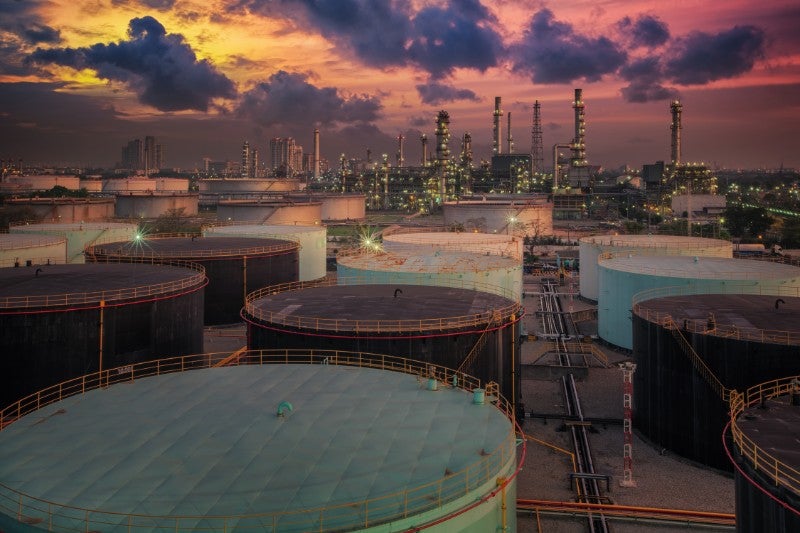
Many oil companies are worth a fraction of what they were at the start of the year. The coronavirus pandemic started a chain of events which led to a global crash in oil prices and slashed. Offshore Technology takes a look at events of the oil price war ahead of Thursday’s “ceasefire” meeting.
The slide in the price of oil started with the outbreak of the Covid-19 coronavirus in China. The country is one of the largest oil markets in the world, providing energy for over 1.3bn people. Its rapid development has fuelled a rapid increase in energy demand.

Discover B2B Marketing That Performs
Combine business intelligence and editorial excellence to reach engaged professionals across 36 leading media platforms.
At the end of 2019, Bloomberg reported China’s oil imports had risen over US imports at their peak. Much of the growth in global oil production in 2020 would have gone to feed the Chinese economy.
In late January, Chinese workers planned for a long weekend over Lunar New Year, but this was extended as workplaces shut down to contain the spread of coronavirus. At the time, it was reported there were 500 known cases.
The streets were deserted and oil consumption fell quickly. The slowdown of China’s giant economy meant consequences for the rest of the world. This was the beginning of the oil price slump.

US Tariffs are shifting - will you react or anticipate?
Don’t let policy changes catch you off guard. Stay proactive with real-time data and expert analysis.
By GlobalDataOPEC takes action
The drop in oil prices continued as demand remained low. To counter this, the Organisation of the Petroleum Exporting Countries (OPEC) scheduled a meeting to agree on cuts to production
Members of OPEC had already agreed to make cuts last year and to extend them in 2020. However, Saudi Arabia proposed maintaining the existing cuts throughout the year, as well as removing another 1.5 million barrels per day (MMbpd) from global production.
OPEC members agreed on this level but proposed Russia should be responsible for 0.5 MMbpd of cuts. The group then put this to representatives of Russia, and talks continued as financial markets closed for the weekend. Russia refused to accept the proposed share, which caused OPEC countries to retaliate by raising production.
Professor and oil economist Dr Mamdouh G Salameh recently told Offshore Technology: “In my opinion, Russia was right to refuse deeper production cuts by OPEC+ as such cuts would have had no positive impact whatsoever on oil prices while the outbreak is raging.”
“Saudi Arabia could never win a price war with Russia. Russia’s economy could live with an oil price of $25 a barrel for years compared with $91 for Saudi Arabia according to the International Monetary Fund.”
Many commentators, such as those at the Financial Times, have said the move was a play by Russia to hurt the US. Although it is the world’s largest oil exporter, the US was not involved in talks. If a deal had been made, the US would have taken an even larger slice of the global oil market.
Multiple producers have announced they will decrease their investment in the US, due to the short cycle and high production cost of projects in shale oil fields.
Where we are now
Currently, markets are rallying in anticipation of a new supply reduction deal. Russia is set to meet OPEC members on Thursday to begin new negotiations.
US President Donald Trump has said he has brokered a deal with Russian ruler Vladimir Putin and OPEC member nations. He claims this will remove 10 MMbpd to 15 MMbpd from global production, the equivalent of 10% – 15% of all world oil production.
His remarks have caused investors to return to oil markets, and prices have steadily risen ahead of the meeting. Markets have put their hopes on large production cuts following the OPEC meeting, though nothing has yet been decided.
What will happen next?
Sources in OPEC told Reuters they expect the agreed level of cuts will depend on how much other producers, such as the US, are willing to cut.
If the US does make a deal with OPEC, it will be the first of its kind. If the deal is as large as President Trump has said, it may give the offshore industry the cash injection it is looking for. Two ING commodities traders told Al Jazeera: “Anything less than this would likely disappoint the market, given growing expectations last week, along with the deteriorating demand picture.”
Following the meeting, OPEC and Russia will speak with energy ministers from G20 economies.
Ultimately, the price of a barrel of oil will follow supply and demand. If traders feel enough production has been cut to address record levels of oversupply, prices will climb back closer to where they were at the start of the year.





